ASRock M8 Barebones Review: My Steam Box
by Ian Cutress on January 2, 2014 10:00 AM EST- Posted in
- Barebones
- Intel
- ASRock
- Motherboards
- Cases/Cooling/PSUs
- Z87
Because it can be difficult to benchmark a barebones, due to our choice in hardware overriding any performance results, I wanted to run my usual CPU benchmark suite to at least indicate where a CPU such as the i7-4765T would perform, given its lower CPU MHz base (2.0 GHz) but highly multithreaded nature. The CPU itself performs well, and outstretches almost all the AMD CPUs in every benchmark, sometimes being eclipsed by the FX-8350 in specific workloads.
Point Calculations - 3D Movement Algorithm Test
The algorithms in 3DPM employ both uniform random number generation or normal distribution random number generation, and vary in various amounts of trigonometric operations, conditional statements, generation and rejection, fused operations, etc. The benchmark runs through six algorithms for a specified number of particles and steps, and calculates the speed of each algorithm, then sums them all for a final score. This is an example of a real world situation that a computational scientist may find themselves in, rather than a pure synthetic benchmark. The benchmark is also parallel between particles simulated, and we test the single thread performance as well as the multi-threaded performance.
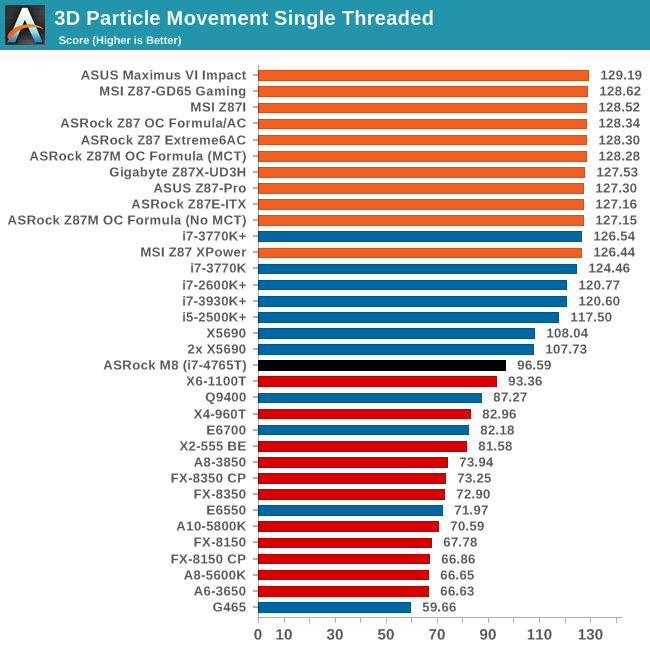
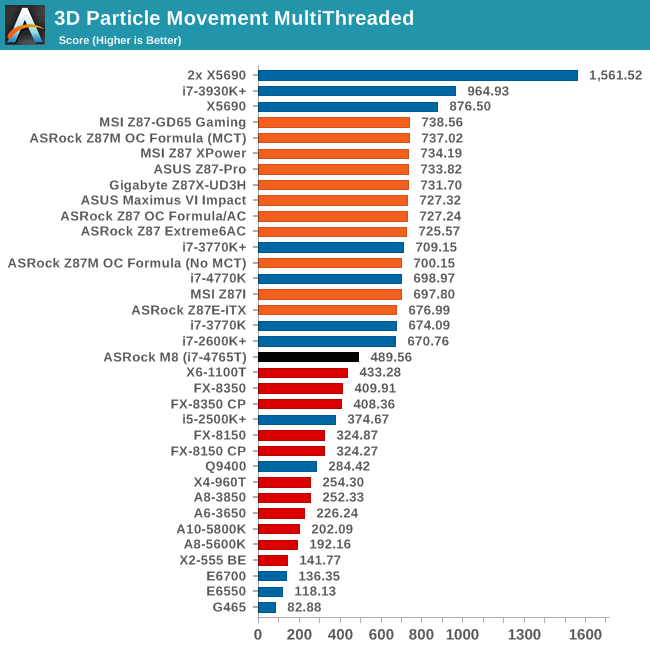
Compression - WinRAR 4.2
With 64-bit WinRAR, we compress the set of files used in the USB speed tests. WinRAR x64 3.93 attempts to use multithreading when possible, and provides as a good test for when a system has variable threaded load. WinRAR 4.2 does this a lot better! If a system has multiple speeds to invoke at different loading, the switching between those speeds will determine how well the system will do.

Image Manipulation - FastStone Image Viewer 4.2
FastStone Image Viewer is a free piece of software I have been using for quite a few years now. It allows quick viewing of flat images, as well as resizing, changing color depth, adding simple text or simple filters. It also has a bulk image conversion tool, which we use here. The software currently operates only in single-thread mode, which should change in later versions of the software. For this test, we convert a series of 170 files, of various resolutions, dimensions and types (of a total size of 163MB), all to the .gif format of 640x480 dimensions.
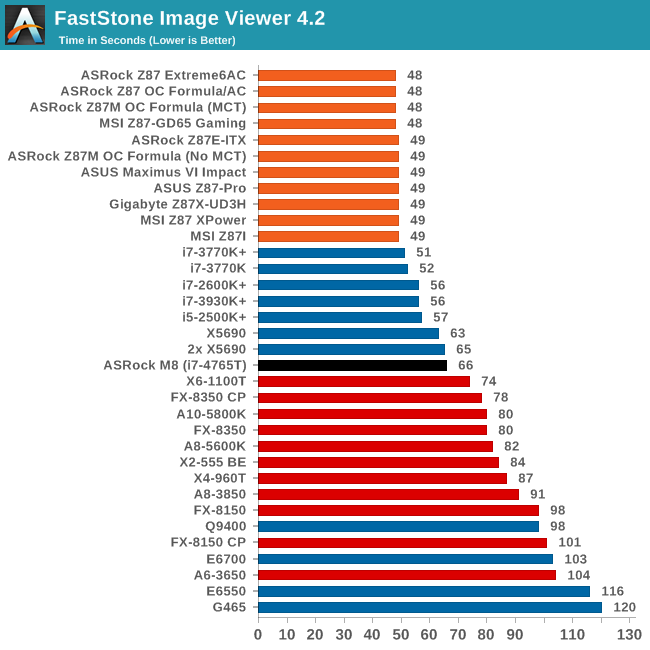
Video Conversion - Xilisoft Video Converter 7
With XVC, users can convert any type of normal video to any compatible format for smartphones, tablets and other devices. By default, it uses all available threads on the system, and in the presence of appropriate graphics cards, can utilize CUDA for NVIDIA GPUs as well as AMD WinAPP for AMD GPUs. For this test, we use a set of 33 HD videos, each lasting 30 seconds, and convert them from 1080p to an iPod H.264 video format using just the CPU. The time taken to convert these videos gives us our result.
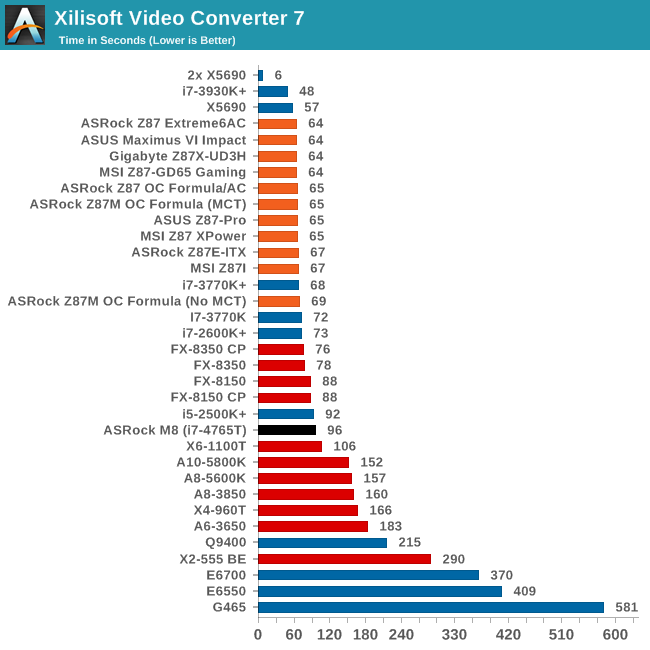
Rendering – PovRay 3.7
The Persistence of Vision RayTracer, or PovRay, is a freeware package for as the name suggests, ray tracing. It is a pure renderer, rather than modeling software, but the latest beta version contains a handy benchmark for stressing all processing threads on a platform. We have been using this test in motherboard reviews to test memory stability at various CPU speeds to good effect – if it passes the test, the IMC in the CPU is stable for a given CPU speed. As a CPU test, it runs for approximately 2-3 minutes on high end platforms.

Video Conversion - x264 HD Benchmark
The x264 HD Benchmark uses a common HD encoding tool to process an HD MPEG2 source at 1280x720 at 3963 Kbps. This test represents a standardized result which can be compared across other reviews, and is dependent on both CPU power and memory speed. The benchmark performs a 2-pass encode, and the results shown are the average of each pass performed four times.
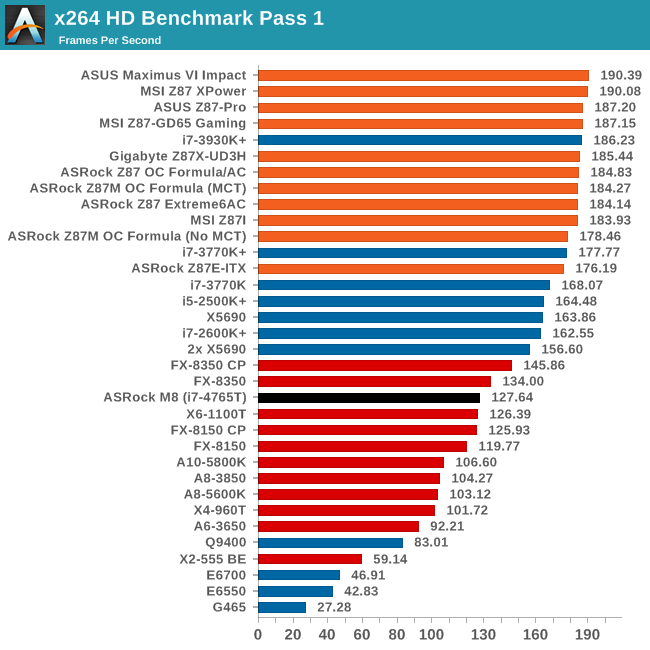
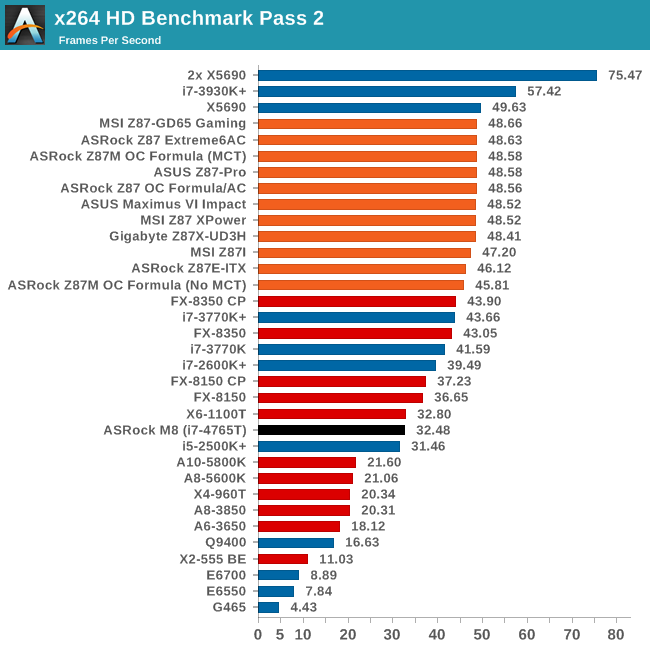
Grid Solvers - Explicit Finite Difference
For any grid of regular nodes, the simplest way to calculate the next time step is to use the values of those around it. This makes for easy mathematics and parallel simulation, as each node calculated is only dependent on the previous time step, not the nodes around it on the current calculated time step. By choosing a regular grid, we reduce the levels of memory access required for irregular grids. We test both 2D and 3D explicit finite difference simulations with 2n nodes in each dimension, using OpenMP as the threading operator in single precision. The grid is isotropic and the boundary conditions are sinks. Values are floating point, with memory cache sizes and speeds playing a part in the overall score.
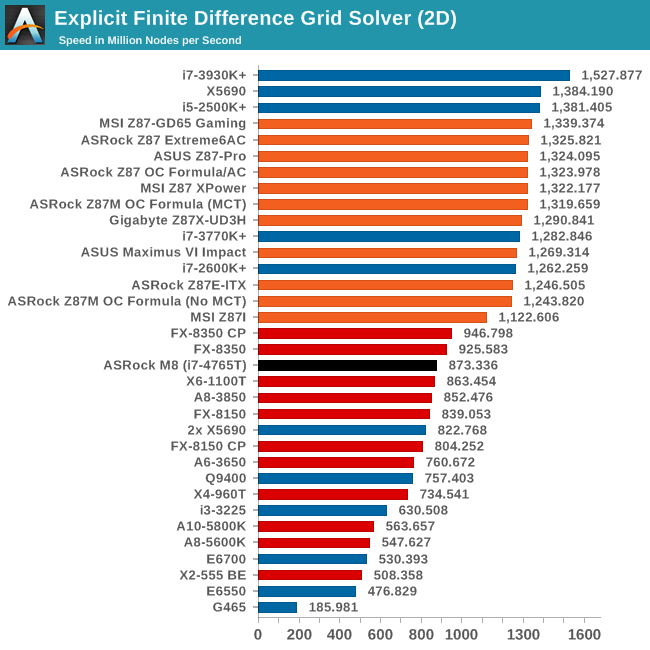
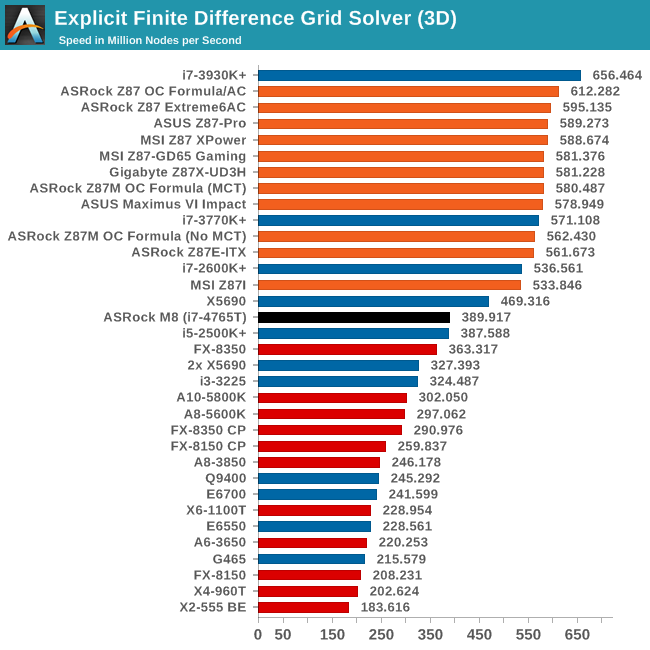
Grid Solvers - Implicit Finite Difference + Alternating Direction Implicit Method
The implicit method takes a different approach to the explicit method – instead of considering one unknown in the new time step to be calculated from known elements in the previous time step, we consider that an old point can influence several new points by way of simultaneous equations. This adds to the complexity of the simulation – the grid of nodes is solved as a series of rows and columns rather than points, reducing the parallel nature of the simulation by a dimension and drastically increasing the memory requirements of each thread. The upside, as noted above, is the less stringent stability rules related to time steps and grid spacing. For this we simulate a 2D grid of 2n nodes in each dimension, using OpenMP in single precision. Again our grid is isotropic with the boundaries acting as sinks. Values are floating point, with memory cache sizes and speeds playing a part in the overall score.
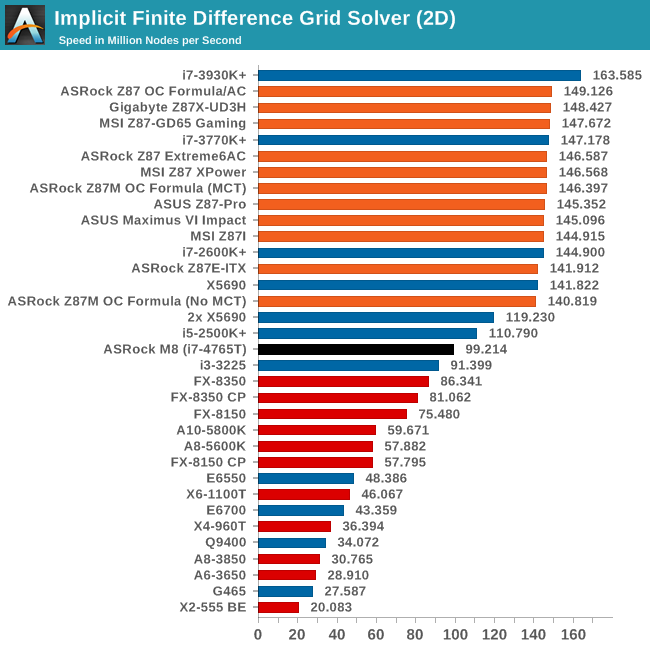
Point Calculations - n-Body Simulation
When a series of heavy mass elements are in space, they interact with each other through the force of gravity. Thus when a star cluster forms, the interaction of every large mass with every other large mass defines the speed at which these elements approach each other. When dealing with millions and billions of stars on such a large scale, the movement of each of these stars can be simulated through the physical theorems that describe the interactions. The benchmark detects whether the processor is SSE2 or SSE4 capable, and implements the relative code. We run a simulation of 10240 particles of equal mass - the output for this code is in terms of GFLOPs, and the result recorded was the peak GFLOPs value.
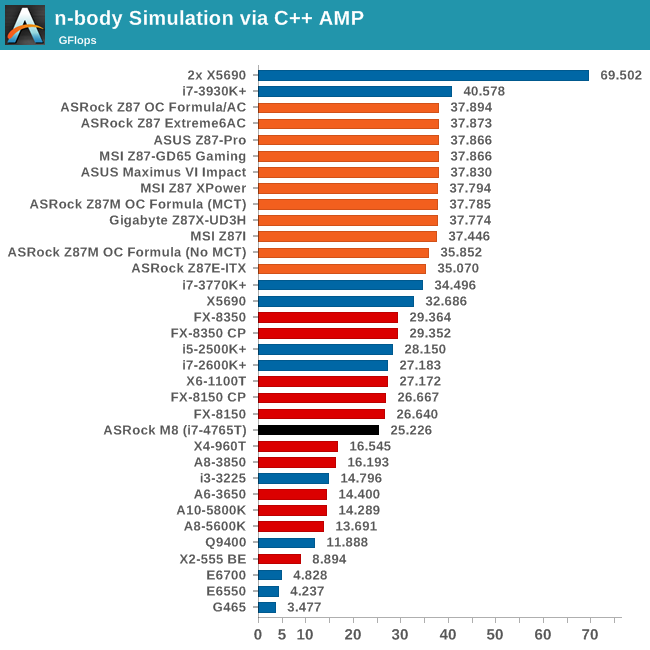










78 Comments
View All Comments
brucek2 - Friday, January 3, 2014 - link
Is the optical drive really DVD only (not Bluray?) If so that seems exactly wrong to me. I'd rather have either no optical drive at all and save the ~$70, or have one that can play Blurays.Death666Angel - Monday, January 6, 2014 - link
German website tweakpc.de says it is blu ray. But I have no idea how you get $70 for a slim DVD ODD. They retail for 20€ here.fuhgetaboutit - Friday, January 3, 2014 - link
Minor nit - article should use one space after a period, not two.http://channel9.msdn.com/Blogs/TheChannel9Team/Bil...
IanCutress - Friday, January 3, 2014 - link
Personal preference, was always taught to use two from the early days and it seems unnatural to my eyes to see only one. There are reams of articles, blogs and even societies and groups for each, just as there are the serial comma (which again I was taught to use, and leaving it out feels wrong), or that companies are plural entities, not singular. I always used double spacing for publishing to scientific journals, never heard a peep from their stylists.Johnmcl7 - Saturday, January 4, 2014 - link
I've always been taught to use two spaces after a full stop, one after a comma and still do partially because it's what I'm used to but I think it looks better as well.John
Gigaplex - Friday, January 3, 2014 - link
Why did they bother using the Z87 chipset? With that minimal power deliver and recommendation to avoid overclocking, it would have been cheaper to use the H87 chipset.theNiZer - Friday, January 3, 2014 - link
Ian Cutress - I am surprised that you seem to take heat and noise considerations so light, especially when many other reviews point out these weaknesses in the M8. And why did you not test these aspects more systematically in the review?IanCutress - Friday, January 3, 2014 - link
I didn't see any issues with heat - I stuck to ASRock's recommended power limit on the GPU and used a low powered 35W CPU rather than a full fat 4770K and overclocking. As for noise, the only equipment I own to measure noise are my android devices, which are not calibrated in any shape or form. Plus I live right next to a main road, so there is always noise of cars going past, affecting any reading. Suffice to say, it is audible at idle at 1 ft away, and does not particularly bother me at full load, but I may be biased by a large threshold due to my location.colonelclaw - Friday, January 3, 2014 - link
The key issue that Valve needs to convince the public about, with regards to Steam Boxes, is that the higher up front cost is considerably offset by the savings you will make on buying games from Steam, especially in tandem with the frequent Steam Sales, Daily Deals, Midweek Madness etc.The problem is that long-sightedness can be a bit of a hard concept for many. $500 for a console, versus maybe $800 for a Steam Box is a hard sell, even though we all know that 20 games at $60 dollars versus 20 games at $15-$20 is a no-brainer.
And that might even be a conservative analogy - I have over 150 games on Steam, at least a quarter of which are AAAs. Being a bit of a cheapskate, I only buy games on sale, yet I never have to wait long after release to do so. The added advantage of this is that if the release was buggy it is more likely to have been fixed by the time it goes on sale.
teldar - Friday, January 3, 2014 - link
You guys need an editor who knows the English language. Reading some of your stuff is brutal.